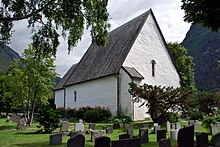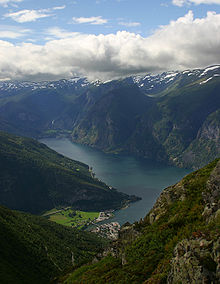Aurlandsvangen
| Aurlandsvangen | ||||
|---|---|---|---|---|
|
||||
| Basic data | ||||
| Country | Norway | |||
| Province (fylke) | Vestland | |||
| Municipality (commune) : | Aurland | |||
| Coordinates : | 60 ° 54 ' N , 7 ° 11' E | |||
| Residents : | 824 (2019) | |||
| Area : | 0.63 km² | |||
| Population density : | 1308 inhabitants per km² | |||


The place Aurlandsvangen (locally mostly called Vangen or Aurland ) is the administrative seat of the Norwegian municipality of Aurland . It is located in the Aurlandsdal on the east side of the Aurlandsfjord , a branch of the Sognefjord , in the province of Vestland . The Aurlandselvi River flows through the settlement and separates the northern center from the southern district of Onstad.
history
The first traces of settlement in Aurlandsvangen can be found in the district of Onstad. Judgment was held there, there was a trading post and an inn. In 1740, the two-storey house was lensmannsgard in Empire style built, which is based on the urban architecture Bergen oriented. The local police were there. The local shop and the inn were merged from two smaller houses into one larger one. It was partially rebuilt at the end of the 18th century and got its current appearance in 1870. The northern part of the village grew in the second half of the 19th century. The oldest branch is to the north of the market square with Vangen Motell and Åbelheim pensjonat in the center. In the 1860s, the place received a post office, a little later a school and other shops, which were also located in the north. The place generally has a large variety of house types and styles, from which the history of the settlement can be read.
population
In the 1845 census, the place had only 42 inhabitants. By 1860 the place already had 120 inhabitants and 60 houses. 14 of them were rented. However, many of the residents did not own any land. They worked as artisans or day laborers and lived mainly on fish. This brought them the name “strandsittarar” (German: people sitting on the beach). In Sogn this was a well-known social structure and it was concentrated in settlements along the fjords, such as in Lærdalsøyri and Vikøyri .
| Aurlandsvangen: Population from 1845 to 2012 | ||||
|---|---|---|---|---|
| year | Residents | |||
| 1845 | 42 | |||
| 1860 | 120 | |||
| 1875 | 111 | |||
| 1890 | 129 | |||
| 1900 | 213 | |||
| 1910 | 234 | |||
| 1920 | 169 | |||
| 1930 | 331 | |||
| 1946 | 439 | |||
| 1950 | 457 | |||
| 1960 | 484 | |||
| 1970 | 606 | |||
| 1980 | 634 | |||
| 1990 | 573 | |||
| 2000 | 560 | |||
| 2009 | 539 | |||
| 2012 | 597 | |||
| 2019 | 824 | |||
| Data source: SSB: Norwegian censuses | ||||
religion
In the late Middle Ages there were two churches in Aurlandsvangen . The Rygg kyrkje no longer exists today. It is not known when this church was consecrated, but it is believed that it was built in the 12th century and used as a Sogn church. It was a wooden church, probably a stave church , that occupied a central place in the northern quarter of the town. From there it was visible from both the fjord and Aurlandsdalen. With the spread of the plague in the 14th century, there was a sharp decline in the population in the municipality of Aurland. The church was no longer visited as often and its maintenance was neglected. In a letter from 1544, King Frederik II described the church as as good as dilapidated and ordered its demolition. The church's cemetery was still used until 1806.
The stone church Vangen kyrkje from 1202 was only 200-300 meters away from the Rygg kyrkje . Since the church is not listed in public documents at the time of the plague epidemics, it underscores the assumption that it was a private estate or family church . Until the Reformation in 1537, all churches in Norway were privately owned, as they either belonged to a court or functioned as a Sogn church and belonged to the people of the respective Sogn. With time and the increasing decline of the Rygg kyrkje , the Vangen kyrkje more and more took over the function of a Sogn church until the Reformation. From 1537 onwards, all churches and church property became the property of the state and were only sold again in the 18th century in order to improve the state treasury. The Vangen kyrkje, like all the other churches in the municipality of Aurland who bought Vogt Hans Thiis Nagel in 1725. They remained until 1889 in private ownership, as the church it bought. The church was restored a total of three times, the first time in the 18th century, then in the 1860s and most recently in 1926. During the last restoration, the roof structure was opened and the old wall painting, which had previously been painted over, was restored. The stained glass is by the artist Emanuel Vigeland. The armory in front of the west gable was removed and parts of the former ceiling construction with the ceiling paintings were used to erect a separate bell tower.
Economy and Infrastructure
traffic
In 1916 a road was built between Aurlandsvangen and the neighboring town of Flåm. 1991 direction were mountains of Flenjatunnel and Gudvanga Tunnel opened in June 2001, the Lærdalstunnelen by Laerdal as the longest road tunnel in the world with over 24 km in length. This created the continuous winter-proof road connection E16 from Oslo to Bergen. Today Aurlandsvangen is located directly on this important connection for Norway. The old road Fv 243 over the mountains leads to the neighboring municipality of Lærdal. It is known as Snøvegen and is now only used as a side road. Since 1980 there has been a connection to Hallingdal via the Fv 50 road .
Before winter-proof roads were built, Aurlandsvangen could only be reached by boat in winter. Since the middle of the 19th century tourism developed in the community of foreign countries and so Aurlandsvangen got a pier in the 1870s that was suitable for steam ships. Furthermore, the place now has a small leisure harbor in Onstad.
tourism
Since the 1850s, the English Lord Garvagh and his servants came regularly to Aurlandsvangen. He also invited his friends and brought his son, born in 1852, with him to Aurland. The English aristocratic society found accommodation in the local inn. Since then the house has been popularly known as the Lord House or English House . Lord Garvagh bought the fishing rights for the Flåmselvi and Aurlandselvi , which he held until his death in 1872. His son, who also made numerous trips to the Aurland, took over his fishing rights. After the fishing season, which ended in autumn, he indulged in reindeer hunting in the surrounding mountains. There he had several hunting lodges built, two of which have survived.
Thanks to the connection to the neighboring town of Flåm, Aurlandsvangen now benefits from tourism. There is a connection to the Flåmsbana railway line and a pier for large cruise ships. The Snøvegen to Lærdalsøyri , one of the 18 nationally funded tourist routes in Norway, starts in Aurlandsvangen . From the Stegastein viewpoint , which is on this route, you have a view of the village, the Aurlandsfjord and the Flenjaeggi mountains opposite Aurlandsvangen . The latter is part of the Nærøyfjord World Heritage Site .
education
Aurlandsvangen has a kindergarten and a school for grades one to ten. The school has a sports field. The Sogn jord- og hagebruksskule is a secondary school for gardening and agriculture.
When the last policeman, Ole AM Onstad, died in 1929, the local history association took over the lensmannsgard house and set up a local history museum in it. Among other things, it exhibits a collection of objects that belonged to Per Sivle , a Norwegian writer from the neighboring town of Flåm.
Personalities
- Absalon Pederssøn Beyer (1528–1575), clergyman, historian, writer and teacher
literature
- Kulturhistorisk vegbok Sogn og fjordane Aurland . Naustdal: Sogn og Fjordane forl., 1991, ISBN 82-91082-00-6 , p. 29-33 .
- Aurlandsvangen. Store norske leksikon , accessed February 14, 2014 (Norwegian).
Web links
Individual evidence
- ↑ Tettsteders following og areal. Statistisk sentralbyrå, November 4, 2019, accessed on August 7, 2020 .
- ↑ a b c Kulturhistorisk vegbok Sogn og fjordane abroad. P. 29.
- ↑ a b Kulturhistorisk vegbok Sogn og fjordane abroad. P. 30.
- ↑ Kulturhistorisk vegbok Sogn og fjordane abroad. P. 28.
- ↑ Kulturhistorisk vegbok Sogn og fjordane abroad. P. 32/33.
- ^ Aurlandsfjellet. In: Nasjonale turistveger. Statens vegvesen , accessed on March 22, 2020 .
- ↑ Kulturhistorisk vegbok Sogn og fjordane abroad. P. 32.




